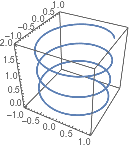
We are going to use that data for two purposes: retrieving a list of large cities and their coordinates and getting the radius of the Earth. Then pick out some data needed for the visualizations from the simulation result object:Īs we work in Mathematica, we have access to continuously updated data sources for a variety of things. Then load and simulate the satellite model for 100,000 seconds: The goal of this post is to illustrate how Mathematica and SystemModeler can work together to answer the questions above in a visual and clear way.įirst, connect Mathematica to SystemModeler by loading the WSMLink package:
#3D PLOT WOLFRAM MATHEMATICA MANUAL#
It cannot, for example, answer questions like “ Over which part of the globe is the satellite?“, “ What is the velocity of the satellite?“, or “ What large city is the satellite closest to?” It could answer the question “ At what altitude is the satellite?“, but that would require some manual computation. This plot alone will not tell you a lot about the satellite. The three curves show the position in the directions x, y, and z. The following plot shows the satellite position in space: Simulation results from a modeled system can often be hard to grasp and hard to understand without further processing and reasoning. This blog post focuses on illustrating the orbit and flight of the satellite in the above model. Model the Earth using a mass with constant rotation, the satellite using a mass with propulsion forces, and the control logic using two proportional derivative (PD) controllers. Using drag-and-drop, create three subsystems. A SystemModeler model combined with data and computational resources in Mathematica can answer all of these questions.Ĭreating such a model is straightforward in SystemModeler. If you want images of cities, you want to know over which cities it currently is. To achieve this, you would want to know where it is at the moment, how high it is, and how fast it’s going. Suppose you are considering using this geocentric LEO satellite to collect image data. LEO is the name given to the altitude range below 2,000 kilometers (1,200 miles). An inclined circular orbit means that the orbit follows a circle, but is not aligned with the equator of the Earth. Geocentric means that it orbits around the Earth. The following model, created in Wolfram SystemModeler, is of a geocentric, inclined circular Low Earth Orbit (LEO) satellite. Other usage areas are weather study, scientific observation, and reconnaissance. Communication satellites are used for both telecommunication and internet access or for navigation services like GPS and GLONASS. Mapping satellites are used to collect satellite images used in maps.

#3D PLOT WOLFRAM MATHEMATICA FREE#
Explore the contents of this article with a free Wolfram SystemModeler trial.Today we rely heavily on satellites orbiting Earth for a variety of purposes.


 0 kommentar(er)
0 kommentar(er)
